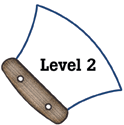|
National Science Education Standards
Each plant or animal has different structures that serve different functions
in growth, survival, and reproduction. For example, humans have distinct
body structures for walking, holding, seeing, and talking. (Page 129)
Plants and animals have life cycles that include being born, developing
into adults, reproducing, and eventually dying. The details of this life
cycle are different for different organisms. (Page 129)
|
|
Benchmarks
A great variety of kinds of living things can be sorted into groups in
many ways using various features to decide which things belong to which
group. (Page 103)
Features used for grouping depend on the purpose of the grouping. (Page
103)
|

